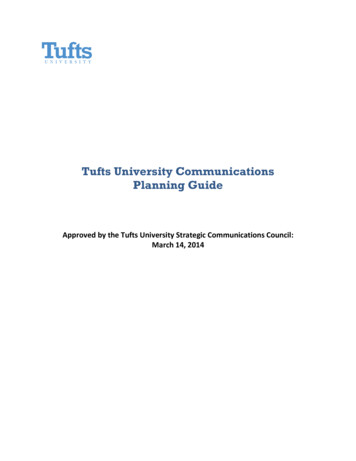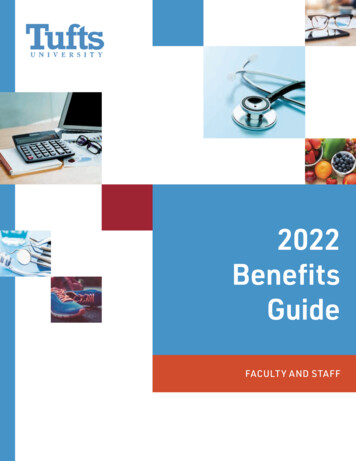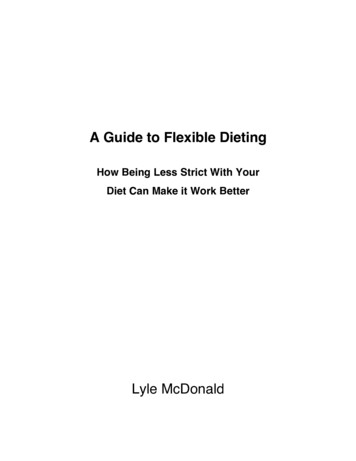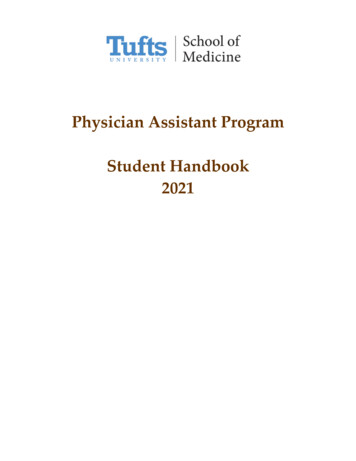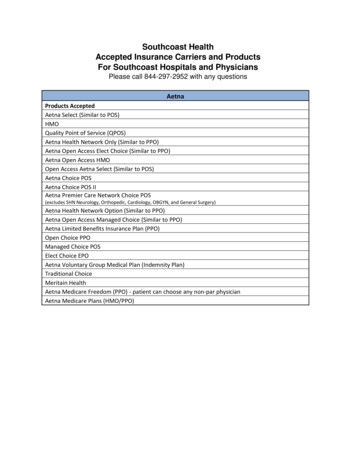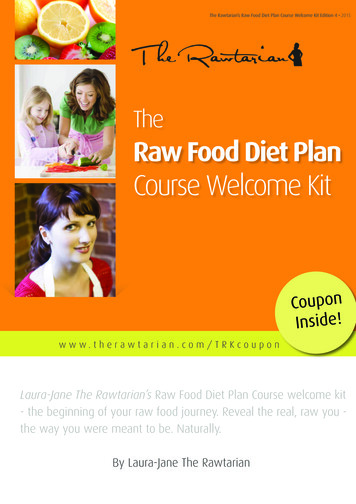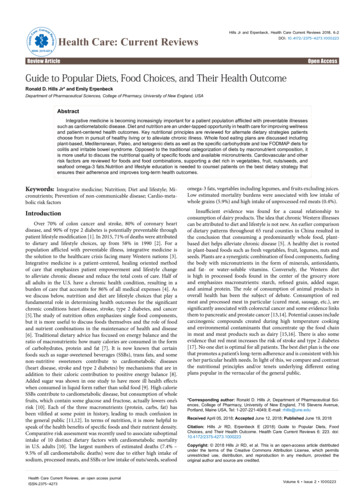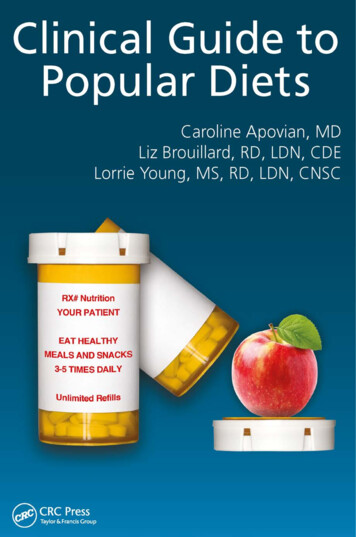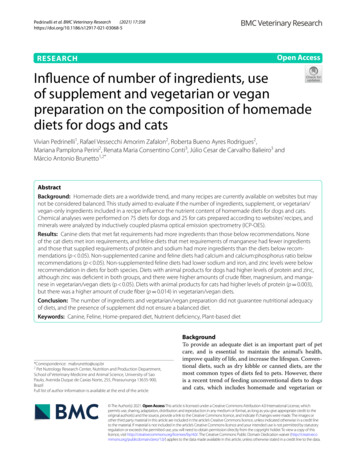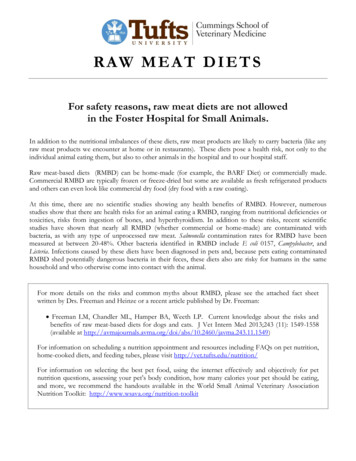
Transcription
RAW MEAT DIETSFor safety reasons, raw meat diets are not allowedin the Foster Hospital for Small Animals.In addition to the nutritional imbalances of these diets, raw meat products are likely to carry bacteria (like anyraw meat products we encounter at home or in restaurants). These diets pose a health risk, not only to theindividual animal eating them, but also to other animals in the hospital and to our hospital staff.Raw meat-based diets (RMBD) can be home-made (for example, the BARF Diet) or commercially made.Commercial RMBD are typically frozen or freeze-dried but some are available as fresh refrigerated productsand others can even look like commercial dry food (dry food with a raw coating).At this time, there are no scientific studies showing any health benefits of RMBD. However, numerousstudies show that there are health risks for an animal eating a RMBD, ranging from nutritional deficiencies ortoxicities, risks from ingestion of bones, and hyperthyroidism. In addition to these risks, recent scientificstudies have shown that nearly all RMBD (whether commercial or home-made) are contaminated withbacteria, as with any type of unprocessed raw meat. Salmonella contamination rates for RMBD have beenmeasured at between 20-48%. Other bacteria identified in RMBD include E coli 0157, Campylobacter, andListeria. Infections caused by these diets have been diagnosed in pets and, because pets eating contaminatedRMBD shed potentially dangerous bacteria in their feces, these diets also are risky for humans in the samehousehold and who otherwise come into contact with the animal.For more details on the risks and common myths about RMBD, please see the attached fact sheetwritten by Drs. Freeman and Heinze or a recent article published by Dr. Freeman: Freeman LM, Chandler ML, Hamper BA, Weeth LP. Current knowledge about the risks andbenefits of raw meat-based diets for dogs and cats. J Vet Intern Med 2013;243 (11): 1549-1558(available at .243.11.1549)For information on scheduling a nutrition appointment and resources including FAQs on pet nutrition,home-cooked diets, and feeding tubes, please visit http://vet.tufts.edu/nutrition/For information on selecting the best pet food, using the internet effectively and objectively for petnutrition questions, assessing your pet’s body condition, how many calories your pet should be eating,and more, we recommend the handouts available in the World Small Animal Veterinary AssociationNutrition Toolkit: http://www.wsava.org/nutrition-toolkit
GENERAL DIETARY RECOMMENDATIONS FOR DOGS AND CATS* Assess a patient’s nutritional status at every visit— Including a thorough diet history and assessmentof weight, body condition and muscle condition. Recommend the diet that is optimal for the individual pet,based on his/her individual health, body condition andactivity level. Feed and recommend a diet made by a well-knownand reputable company – some criteria include:About the Authors— Employing at least one full-time qualified nutritionist(either a PhD nutritionist or an American Collegeof Veterinary Nutrition board-certified veterinarynutritionist).— Having their own manufacturing plants.— Conducting and publishing nutritional research so thatcontinued improvements are made to their diets(and to our collective knowledge about pet nutrition).— Using strict internal quality control testing andstandards (e.g., ingredients, end product, shelflife, accountability).*Note that dogs and cats with certain medical conditions may benefit fromcustomized dietary modifications where consultation with a veterinarynutritionist who is board-certified by the American College of VeterinaryNutrition (ACVN; www.acvn.org) may be beneficial.REFERENCESDillitzer N, Becker N, Kienzle E. Intake of minerals, trace elements and vitamins in boneand raw food rations in adults dogs. Brit J Nutr 2011; 106: S53-S56.LeJeune JT, Hancock DD. Public health concerns associated with feeding raw meat dietsto dogs. J Am Vet Med Assoc 2001; 219; 1222-1225.FDA guidance for industry: Manufacture and labeling of raw meat foods for companionand captive noncompanion carnivores & omnivores: dfLenz J, Joffe D, Kauffman, et al. Perceptions, practices, and consequences associated withfoodborne pathogens and the feeding of raw meat to dogs. Can Vet J 2009; 50: 637-643.degree at Tufts Cummings School ofVeterinary Medicine and received aPhD in Nutrition from Tufts FriedmanSchool of Nutrition Science andPolicy. After a residency in ClinicalNutrition, she was board-certified bythe American College of VeterinaryNutrition. She has been on faculty atTufts Cummings School of VeterinaryMedicine since 1996, where she iscurrently a Professor in the Departmentof Clinical Sciences. Dr. Freemanteaches veterinary students aboutcompanion animal nutrition andcares for patients that requirespecialized nutrition for acuteand chronic diseases.Leonard EK, Pearl DL, Finley RL, et al. Evaluation of pet-related management factorsand the risk of Salmonella spp. carriage in pet dogs from volunteer households in Ontario(2005-2006). Zoonoses Public Health 2011; 58: 140-149.Finley R, Reid-Smith R, Weese JS. Human health implications of Salmonella-contaminatednatural pet treats and raw pet food. Clin Infect Dis 2006; 42: 686-691.Finley R, Ribble C, Aramini J, et al. The risk of salmonellae shedding by dogs fed Salmonella-contaminated commercial raw food diets. Can Vet J 2007; 48: 69-75.Morley PS, Strohmeyer RA, Tankson JD, et al. Evaluation of the association between feeding raw meat and Salmonella enterica infections at a Greyhound breeding facility. J Am VetMed Assoc 2006; 228: 1524-1532.Finley R, Reid-Smith R, Ribble C, et al. The occurrence and antimicrobial susceptibility ofSalmonellae isolated from commercially available canine raw food diets in three Canadiancities. Zoonoses Public Health 2008; 55: 462-469.Stiver SL, Frazier KS, Mauel MJ, Styer EL. Septicemic salmonellosis in two cats fed a rawmeat diet. J Am Anim Hosp Assoc 2003; 39: 538-542.Joffe DJ, Schlesinger DP. Preliminary assessment of the risk of Salmonella infection indogs fed raw chicken diets. Can Vet J 2002; 43: 441-442.Strohmeyer RA, Morley PS, Hyatt DR, et al. Evaluation of bacterial and protozoal contamination of commercially available raw meat diets for dogs. J Am Vet Med Assoc 2006; 228:537-542.Kerr KR, Vester Boler BM, Morris CL, et al. Apparent total tract energy and macronutrient digestibility and fecal fermentative end-product concentrations of domestic cats fedextruded, raw beef-based, and cooked beef-based diets. J Anim Sci 2012; 90: 515-522.Taylor MB, Geiger DA, Saker KE, Larson MM. Diffuse osteopenia and myelopathy in apuppy fed a diet composed of an organic premix and raw ground beef. J Am Vet MedAssoc 2009; 234: 1041-1048.Köhler B, Stengel C, Neiger-Casas R. Dietary hyperthyroidism in dogs. J Small Anim Pract2012; 53: 182-184.Weese JS, Rousseau J, Arroyo L. Bacteriological evaluation ofcommercial canine & feline raw diets. Can Vet J 2005;46:513-516.KuKanich KS. Update on Salmonella spp contamination of pet food, treats, and nutritionalproducts and safe feeding recommendations. J Am Vet Med Assoc 2011; 238: 1430-1434.Weese JS, Rousseau J. Survival of Salmonella Copenhagen in food bowls followingcontamination with experimentally inoculated raw meat: Effects of time, cleaning, anddisinfection. Can Vet J 2006; 47: 887–889.Lefebvre SL, Reid-Smith R, Boerlin P, Weese JS. Evaluation of the risk of sheddingsalmonellae and other potential pathogens by therapy dogs fed raw diets in Ontario andAlberta. Zoonoses Public Health 2008; 55: 470-480.Wynn SG, Bartges JW, Dodd WJ. Routine laboratory parameters in healthy dogs fed rawfood diets (abstract). AAVN Clinical Nutrition and Research Symposium, Charlotte, NC,June 4, 2003.Sponsored through a P&G Pet Care educational grant to provide educational information from leading experts on nutritionto pet owners. For more information on P&G Pet Care, visit PGpetwellness.com, Iams.com, Eukanuba.com, Naturapet.com.4 2012 P&GRaw meat diets, arethey worth the risk?Raw meat diets can be homemade from various recipes (e.g., BARF or UltimateDiet) and are also available commercially from a variety of companies. Commercialraw diets are typically frozen or freeze-dried but some can even look like regulardry food (e.g., diets with a raw meat coating).ARE RAW MEAT DIETS HEALTHIER?Proponents of raw meat diets anecdotally report numerous benefits, but, atthis time, there are no scientific studies showing any health benefits from rawmeat diets. One recent study in cats did show a small increase in digestibilityfrom a raw beef-based diet compared to a commercial extruded diet (about8 percent higher for total energy digestibility [Kerr et al, 2012]). However, therewas no difference in digestibility between the raw meat diet and a cooked meatdiet, suggesting that the difference was not the result of the diet being raw. Theeffects of this small, but significant, difference in digestibility in non-extrudeddiets warrants additional research but does not appear to provide sufficientevidence to outweigh the potential risks for raw meat diets. There are an increasingnumber of studies that show important concerns for nutritional imbalances,health risks to the animal and public health concerns.No scientific studies have been publishedshowing the health benefits from raw meat diets.Schlesinger DP, Joffe DJ. Raw food diets in companion animals: A critical review. Can VetJ 2011; 52: 50-54.Freeman LM, Michel KE. Evaluation of raw food diets. J Am Vet Med Assoc 2001; 218:705-709 (correction, J Am Vet Med Assoc 2001; 218: 1716).RD 401Lisa M. Freeman, DVM, PhD,DACVN completed her DVMNumber 1, December 2012Cailin R. Heinze, VMD, MS,DACVN earned her VMD degreefrom the University of PennsylvaniaSchool of Veterinary Medicine. Afterveterinary school, she worked inprivate practice for three yearsbefore pursuing a residency in clinicalnutrition at the University of California, Davis. While at Davis, Dr. Heinzeearned a Master’s degree in NutritionalBiology. She is currently an AssistantProfessor of Nutrition at TuftsCummings School of VeterinaryMedicine. Her professional interestsinclude canine and feline obesity,nutritional management of renaldisease, long-chain fatty acids andcancer nutrition.1
NUTRITIONAL IMBALANCESPotential health concernsof feeding raw meat diets include:A small study from the United States in 2001demonstrated that all homemade and commercial rawfood diets tested (3 homemade and 2 commercial) hadmultiple nutritional imbalances, some of which couldhave important health effects for the animal (Freemanand Michel, 2001). A recent European study calculatedlevels of 12 nutrients (e.g., calcium, phosphorus, vitaminA) for 95 homemade raw meat diets being fed to dogs asreported by the owners (Dillitzer et al, 2011). In this study,60 percent of the diets had major nutritional imbalances.Therefore, there is concern that both commercial andhomemade raw meat diets may have important nutrientdeficiencies and excesses. In addition, even if these dietsmeet the minimum nutrient levels and don’t exceed themaximums, they may not provide an optimal nutrientprofile. For example, many raw meat diets may be veryhigh in fat compared to typical canned and dry diets,which may make the coat look shiny, but could causehealth problems for some animals.TOP TEN MYTHS ABOUT RAW MEAT DIETS Gastroenteritis Fractured teethMYTH 1: “Their benefits are proven.”MYTH 5: “Freezing raw diets kills bacteria.” SepsisNo scientific studies have shown benefits of rawdiets. Their appeal is based on word of mouth, testimonials and perceived benefits. For example, raw food dietsmay result in a shiny coat and small stools because theyare generally high in fat and digestibility. However, thesesame properties can be achieved with commercialcooked diets without the risks of raw meat diets.Most of the bacteria found in raw meatdiets can easily survive freezing (and freeze-drying).CONTAMINATION RISKSMore research is needed to fully understand the potentialhealth effects of raw meat diets. However, a large body ofresearch has been completed on the high risk for pathogenic bacterial contamination of raw meat diets and thepotential risks posed by this problem. Like any raw meatproducts we encounter at home or in restaurants, rawmeat diets have the potential to carry pathogenic bacteria. Therefore, these diets pose a health risk, not onlyto the individual pet eating them, but also to the animalsand people around them.Recent scientific studies have shown that nearly all rawmeat diets (whether commercial or homemade) arecontaminated with bacteria. Some of these bacteria areunlikely to have negative effects on health, but otherscan have serious consequences. For example, studieshave found that between 20-44 percent of commercialraw meat diets are contaminated with Salmonella (Weeseet al, 2005; Strohmeyer et al, 2006; Finley et al, 2007).Animals eating raw meat diets can shed these bacteria intheir feces (Joffe et al, 2002; Finley et al, 2007). In onestudy, approximately half the dogs fed a single meal ofcontaminated raw food shed Salmonella in their fecesfor up to 7 days (Finley et al, 2007). Other bacteria thathave been found in raw meat diets include E. coli 0157:H7and Clostridium (Freeman and Michel, 2001; Weese et al,2005). These bacteria are a risk, not only for the animalseating the diets, but also for other pets and people in thehousehold. This is particularly true for any people or animals who are young, old, pregnant or immunosuppressed.Of even greater concern is the issue of antibiotic resistance. A study from Canada found that 21 percent of allraw meat diets tested were contaminated with Salmonellaand that these bacteria showed resistance to 75 percentof the antibiotics tested (Finley et al, 2008).Most homemade and many commercial rawmeat diets are not nutritionally balanced.HEALTH RISKSIn addition to the many health problems that can developas the result of deficient or excessive intake of nutrients(e.g., calcium: phosphorus imbalances; Taylor et al,2009), other risks of raw meat diets include gastroenteritis (inflammation of the gastrointestinal tract, usuallyresulting in vomiting and diarrhea) which could be due tobacteria in the diet or high dietary fat levels and, for rawmeat diets that contain bones, fractured teeth and gastrointestinal injury can occur. However, research is neededto better understand how frequently these complicationsarise. Because of the high potential for contamination withpathogenic bacteria (see below), bacterial infection canoccur (e.g., Salmonella or Clostridium). This can result ingastrointestinal disease, septicemia and even death(Stiver et al, 2003; Morley et al, 2006). Other negativehealth effects are being identified as well. A recent studyidentified 12 dogs with hyperthyroidism caused by eatingraw meat diets (Kohler et al, 2012).Finally, an unpublished study found that dogs eating rawmeat diets had significantly higher blood urea nitrogen,creatinine and hematocrit values compared to controls(Wynn et al, 2003). Similarly, albumin and cholesterol werehigher than the reference range in cats fed a raw meat diet(Kerr et al, 2012). While it is unclear whether these findingshave any long-term health implications for the animal, it emphasizes the importance of knowing the complete dietaryhistory for all animals to be able to accurately interpret theresults of laboratory tests.MYTH 6: “As long as bones are raw,they’re safe.”Bones, whether raw or cooked, can fracturedogs’ and cats’ teeth. Bone also can block or tear theesophagus, stomach or intestine.MYTH 2: “This is what animals eat in the wild.”MYTH 7: “Cooking destroys enzymes neededfor digestion.”Wolves in the wild do eat raw meat (in additionto berries, plants, etc). However, the average lifespan for awolf in the wild is only a few years. Therefore, what is nutritionally “optimal” for a wolf is not optimal for our petsthat we hope will live long and healthy lives.All the enzymes that dogs and cats (and people) need for digestion are already in the gastrointestinaltract. Therefore, additional enzymes from food are notrequired for digestion.MYTH 3: “Dogs and cats can’t get infections fromSalmonella or other bacteria in raw meat diets.”MYTH 8: “Raw diets do not contain grains, becausegrains are added to pet foods only as fillers.”Dogs and cats can become infected with Salmonella, Clostridium, Campylobacter and other bacteria foundin raw meat diets, just as people can (especially young,old or immunosuppressed individuals).Corn, oats, rice, barley and other grains arehealthy ingredients that contain protein, vitamins andminerals; they are not added as fillers and are unlikelyto cause allergies. Although meat is an important component of diets for dogs and cats, grains can be partof a high-quality, nutritionally balanced diet.MYTH 4: “Raw food diet ingredients arehuman grade.”Even meats purchased at the best of storesfor people can contain harmful bacteria, so purchasing “human grade” meat does not protect against thehealth risks of uncooked meats (would you eat rawground beef?). It is also important to keep in mind thatthe term “human grade” has no legal definition for petfood.MYTH 9: “Most commercial pet foods containharmful ingredients such as by-products.”By-products are the animal parts thatAmericans don’t typically eat, such as livers, kidneys orlungs. There are specific definitions for what by-productscan and cannot include. For example, by-products mustbe the clean parts of slaughtered animals and cannotinclude feathers, hair, horns, teeth and hooves. Basically,by-products are organs and meats other than animalmuscle. Note that some pet foods may actually list theseingredients (e.g., duck liver, beef lung) but these are reallyjust “by-products.” Most commercial and many homeprepared raw diets also contain by-products.Potential nutritional concerns associated withfeeding raw meat diets include:MYTH 10: “If bones or chicken necks are addedto raw meat diets, they’re nutritionally balanced.” Nutrient excesses Nutrient deficienciesMost homemade (and even some commercial)raw meat diets are extremely deficient in calcium and avariety of other nutrients, even if chicken necks, bones oregg shells are added. This can be disastrous in any animalbut especially in young, growing pets and can result infractured bones. Nutrient imbalances such ascalcium: phosphorus imbalance23
NUTRITIONAL IMBALANCESPotential health concernsof feeding raw meat diets include:A small study from the United States in 2001demonstrated that all homemade and commercial rawfood diets tested (3 homemade and 2 commercial) hadmultiple nutritional imbalances, some of which couldhave important health effects for the animal (Freemanand Michel, 2001). A recent European study calculatedlevels of 12 nutrients (e.g., calcium, phosphorus, vitaminA) for 95 homemade raw meat diets being fed to dogs asreported by the owners (Dillitzer et al, 2011). In this study,60 percent of the diets had major nutritional imbalances.Therefore, there is concern that both commercial andhomemade raw meat diets may have important nutrientdeficiencies and excesses. In addition, even if these dietsmeet the minimum nutrient levels and don’t exceed themaximums, they may not provide an optimal nutrientprofile. For example, many raw meat diets may be veryhigh in fat compared to typical canned and dry diets,which may make the coat look shiny, but could causehealth problems for some animals.TOP TEN MYTHS ABOUT RAW MEAT DIETS Gastroenteritis Fractured teethMYTH 1: “Their benefits are proven.”MYTH 5: “Freezing raw diets kills bacteria.” SepsisNo scientific studies have shown benefits of rawdiets. Their appeal is based on word of mouth, testimonials and perceived benefits. For example, raw food dietsmay result in a shiny coat and small stools because theyare generally high in fat and digestibility. However, thesesame properties can be achieved with commercialcooked diets without the risks of raw meat diets.Most of the bacteria found in raw meatdiets can easily survive freezing (and freeze-drying).CONTAMINATION RISKSMore research is needed to fully understand the potentialhealth effects of raw meat diets. However, a large body ofresearch has been completed on the high risk for pathogenic bacterial contamination of raw meat diets and thepotential risks posed by this problem. Like any raw meatproducts we encounter at home or in restaurants, rawmeat diets have the potential to carry pathogenic bacteria. Therefore, these diets pose a health risk, not onlyto the individual pet eating them, but also to the animalsand people around them.Recent scientific studies have shown that nearly all rawmeat diets (whether commercial or homemade) arecontaminated with bacteria. Some of these bacteria areunlikely to have negative effects on health, but otherscan have serious consequences. For example, studieshave found that between 20-44 percent of commercialraw meat diets are contaminated with Salmonella (Weeseet al, 2005; Strohmeyer et al, 2006; Finley et al, 2007).Animals eating raw meat diets can shed these bacteria intheir feces (Joffe et al, 2002; Finley et al, 2007). In onestudy, approximately half the dogs fed a single meal ofcontaminated raw food shed Salmonella in their fecesfor up to 7 days (Finley et al, 2007). Other bacteria thathave been found in raw meat diets include E. coli 0157:H7and Clostridium (Freeman and Michel, 2001; Weese et al,2005). These bacteria are a risk, not only for the animalseating the diets, but also for other pets and people in thehousehold. This is particularly true for any people or animals who are young, old, pregnant or immunosuppressed.Of even greater concern is the issue of antibiotic resistance. A study from Canada found that 21 percent of allraw meat diets tested were contaminated with Salmonellaand that these bacteria showed resistance to 75 percentof the antibiotics tested (Finley et al, 2008).Most homemade and many commercial rawmeat diets are not nutritionally balanced.HEALTH RISKSIn addition to the many health problems that can developas the result of deficient or excessive intake of nutrients(e.g., calcium: phosphorus imbalances; Taylor et al,2009), other risks of raw meat diets include gastroenteritis (inflammation of the gastrointestinal tract, usuallyresulting in vomiting and diarrhea) which could be due tobacteria in the diet or high dietary fat levels and, for rawmeat diets that contain bones, fractured teeth and gastrointestinal injury can occur. However, research is neededto better understand how frequently these complicationsarise. Because of the high potential for contamination withpathogenic bacteria (see below), bacterial infection canoccur (e.g., Salmonella or Clostridium). This can result ingastrointestinal disease, septicemia and even death(Stiver et al, 2003; Morley et al, 2006). Other negativehealth effects are being identified as well. A recent studyidentified 12 dogs with hyperthyroidism caused by eatingraw meat diets (Kohler et al, 2012).Finally, an unpublished study found that dogs eating rawmeat diets had significantly higher blood urea nitrogen,creatinine and hematocrit values compared to controls(Wynn et al, 2003). Similarly, albumin and cholesterol werehigher than the reference range in cats fed a raw meat diet(Kerr et al, 2012). While it is unclear whether these findingshave any long-term health implications for the animal, it emphasizes the importance of knowing the complete dietaryhistory for all animals to be able to accurately interpret theresults of laboratory tests.MYTH 6: “As long as bones are raw,they’re safe.”Bones, whether raw or cooked, can fracturedogs’ and cats’ teeth. Bone also can block or tear theesophagus, stomach or intestine.MYTH 2: “This is what animals eat in the wild.”MYTH 7: “Cooking destroys enzymes neededfor digestion.”Wolves in the wild do eat raw meat (in additionto berries, plants, etc). However, the average lifespan for awolf in the wild is only a few years. Therefore, what is nutritionally “optimal” for a wolf is not optimal for our petsthat we hope will live long and healthy lives.All the enzymes that dogs and cats (and people) need for digestion are already in the gastrointestinaltract. Therefore, additional enzymes from food are notrequired for digestion.MYTH 3: “Dogs and cats can’t get infections fromSalmonella or other bacteria in raw meat diets.”MYTH 8: “Raw diets do not contain grains, becausegrains are added to pet foods only as fillers.”Dogs and cats can become infected with Salmonella, Clostridium, Campylobacter and other bacteria foundin raw meat diets, just as people can (especially young,old or immunosuppressed individuals).Corn, oats, rice, barley and other grains arehealthy ingredients that contain protein, vitamins andminerals; they are not added as fillers and are unlikelyto cause allergies. Although meat is an important component of diets for dogs and cats, grains can be partof a high-quality, nutritionally balanced diet.MYTH 4: “Raw food diet ingredients arehuman grade.”Even meats purchased at the best of storesfor people can contain harmful bacteria, so purchasing “human grade” meat does not protect against thehealth risks of uncooked meats (would you eat rawground beef?). It is also important to keep in mind thatthe term “human grade” has no legal definition for petfood.MYTH 9: “Most commercial pet foods containharmful ingredients such as by-products.”By-products are the animal parts thatAmericans don’t typically eat, such as livers, kidneys orlungs. There are specific definitions for what by-productscan and cannot include. For example, by-products mustbe the clean parts of slaughtered animals and cannotinclude feathers, hair, horns, teeth and hooves. Basically,by-products are organs and meats other than animalmuscle. Note that some pet foods may actually list theseingredients (e.g., duck liver, beef lung) but these are reallyjust “by-products.” Most commercial and many homeprepared raw diets also contain by-products.Potential nutritional concerns associated withfeeding raw meat diets include:MYTH 10: “If bones or chicken necks are addedto raw meat diets, they’re nutritionally balanced.” Nutrient excesses Nutrient deficienciesMost homemade (and even some commercial)raw meat diets are extremely deficient in calcium and avariety of other nutrients, even if chicken necks, bones oregg shells are added. This can be disastrous in any animalbut especially in young, growing pets and can result infractured bones. Nutrient imbalances such ascalcium: phosphorus imbalance23
GENERAL DIETARY RECOMMENDATIONS FOR DOGS AND CATS* Assess a patient’s nutritional status at every visit— Including a thorough diet history and assessmentof weight, body condition and muscle condition. Recommend the diet that is optimal for the individual pet,based on his/her individual health, body condition andactivity level. Feed and recommend a diet made by a well-knownand reputable company – some criteria include:About the Authors— Employing at least one full-time qualified nutritionist(either a PhD nutritionist or an American Collegeof Veterinary Nutrition board-certified veterinarynutritionist).— Having their own manufacturing plants.— Conducting and publishing nutritional research so thatcontinued improvements are made to their diets(and to our collective knowledge about pet nutrition).— Using strict internal quality control testing andstandards (e.g., ingredients, end product, shelflife, accountability).*Note that dogs and cats with certain medical conditions may benefit fromcustomized dietary modifications where consultation with a veterinarynutritionist who is board-certified by the American College of VeterinaryNutrition (ACVN; www.acvn.org) may be beneficial.REFERENCESDillitzer N, Becker N, Kienzle E. Intake of minerals, trace elements and vitamins in boneand raw food rations in adults dogs. Brit J Nutr 2011; 106: S53-S56.LeJeune JT, Hancock DD. Public health concerns associated with feeding raw meat dietsto dogs. J Am Vet Med Assoc 2001; 219; 1222-1225.FDA guidance for industry: Manufacture and labeling of raw meat foods for companionand captive noncompanion carnivores & omnivores: dfLenz J, Joffe D, Kauffman, et al. Perceptions, practices, and consequences associated withfoodborne pathogens and the feeding of raw meat to dogs. Can Vet J 2009; 50: 637-643.degree at Tufts Cummings School ofVeterinary Medicine and received aPhD in Nutrition from Tufts FriedmanSchool of Nutrition Science andPolicy. After a residency in ClinicalNutrition, she was board-certified bythe American College of VeterinaryNutrition. She has been on faculty atTufts Cummings School of VeterinaryMedicine since 1996, where she iscurrently a Professor in the Departmentof Clinical Sciences. Dr. Freemanteaches veterinary students aboutcompanion animal nutrition andcares for patients that requirespecialized nutrition for acuteand chronic diseases.Leonard EK, Pearl DL, Finley RL, et al. Evaluation of pet-related management factorsand the risk of Salmonella spp. carriage in pet dogs from volunteer households in Ontario(2005-2006). Zoonoses Public Health 2011; 58: 140-149.Finley R, Reid-Smith R, Weese JS. Human health implications of Salmonella-contaminatednatural pet treats and raw pet food. Clin Infect Dis 2006; 42: 686-691.Finley R, Ribble C, Aramini J, et al. The risk of salmonellae shedding by dogs fed Salmonella-contaminated commercial raw food diets. Can Vet J 2007; 48: 69-75.Morley PS, Strohmeyer RA, Tankson JD, et al. Evaluation of the association between feeding raw meat and Salmonella enterica infections at a Grey
Animals eating raw meat diets can shed these bacteria in their feces (Joffe et al, 2002; Finley et al, 2007). In one study, approximately half the dogs fed a single meal of contaminated raw food shed Salmonella in their feces for up to 7 days (Finley et al, 2007). Other bacteria that have been found i
